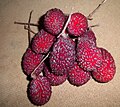| Nephelium | |
|---|---|
 | |
| Nephelium lappaceum fruits | |
| Scientific classification | |
| Kingdom: | Plantae |
| Clade: | Tracheophytes |
| Clade: | Angiosperms |
| Clade: | Eudicots |
| Clade: | Rosids |
| Order: | Sapindales |
| Family: | Sapindaceae |
| Tribe: | Nephelieae |
| Genus: | Nephelium L. [1] |
| Species | |
See text | |
Nephelium is a genus of about 25 species of flowering plants in the family Sapindaceae, native to southeastern Asia.
They are evergreen trees with pinnately compound leaves, and edible drupaceous fruit; one species, N. lappaceum (rambutan) is commercially important for its fruit. The genus is closely related to Litchi and Dimocarpus .
- Selected species
| Image | Scientific name | Common name | Distribution |
|---|---|---|---|
| Nephelium aculeatum | Rambutan-utan | Borneo (Sabah) | |
| Nephelium chryseum | China, Borneo, the Philippines, and Vietnam | ||
| Nephelium compressum | Borneo | ||
| Nephelium costatum | Malaysia | ||
| Nephelium cuspidatum | Lotong, sibau | Borneo | |
| Nephelium daedaleum | Borneo | ||
| Nephelium hamulatum | Peninsular Malaysia | ||
| Nephelium havilandii | Borneo (Sarawak) | ||
 | Nephelium hypoleucum | Korlan | Indo-China to Peninsula Malaysia (Kedah) |
| Nephelium juglandifolium | Peninsula Malaysia to western Jawa | ||
 | Nephelium lappaceum | Rambutan | Thailand to western Malesia |
| Nephelium laurinum | Peninsula Thailand to western Malesia | ||
| Nephelium macrophyllum | Borneo | ||
| Nephelium maingayi | Redan | Malay Peninsula, Sumatra and Borneo | |
| Nephelium meduseum | Borneo | ||
| Nephelium malaiense | Philippines | ||
| Nephelium melanomiscum | Southern Indochina to Peninsula Malaysia | ||
| Nephelium melliferum | Southern Indochina to Peninsula Malaysia | ||
| Nephelium papillatum | Borneo (Sabah) | ||
 | Nephelium ramboutan-ake | Kapulasan | Peninsular Malaysia |
| Nephelium reticulatum | Borneo | ||
| Nephelium subfalcatum | Western Malesia | ||
| Nephelium toong | Indochina | ||
| Nephelium topengii | Hainan | ||
| Nephelium uncinatum | Nicobar Islands to western Malesia | ||
 | Nephelium xerospermoides | Hairless rambutan | Vietnam |